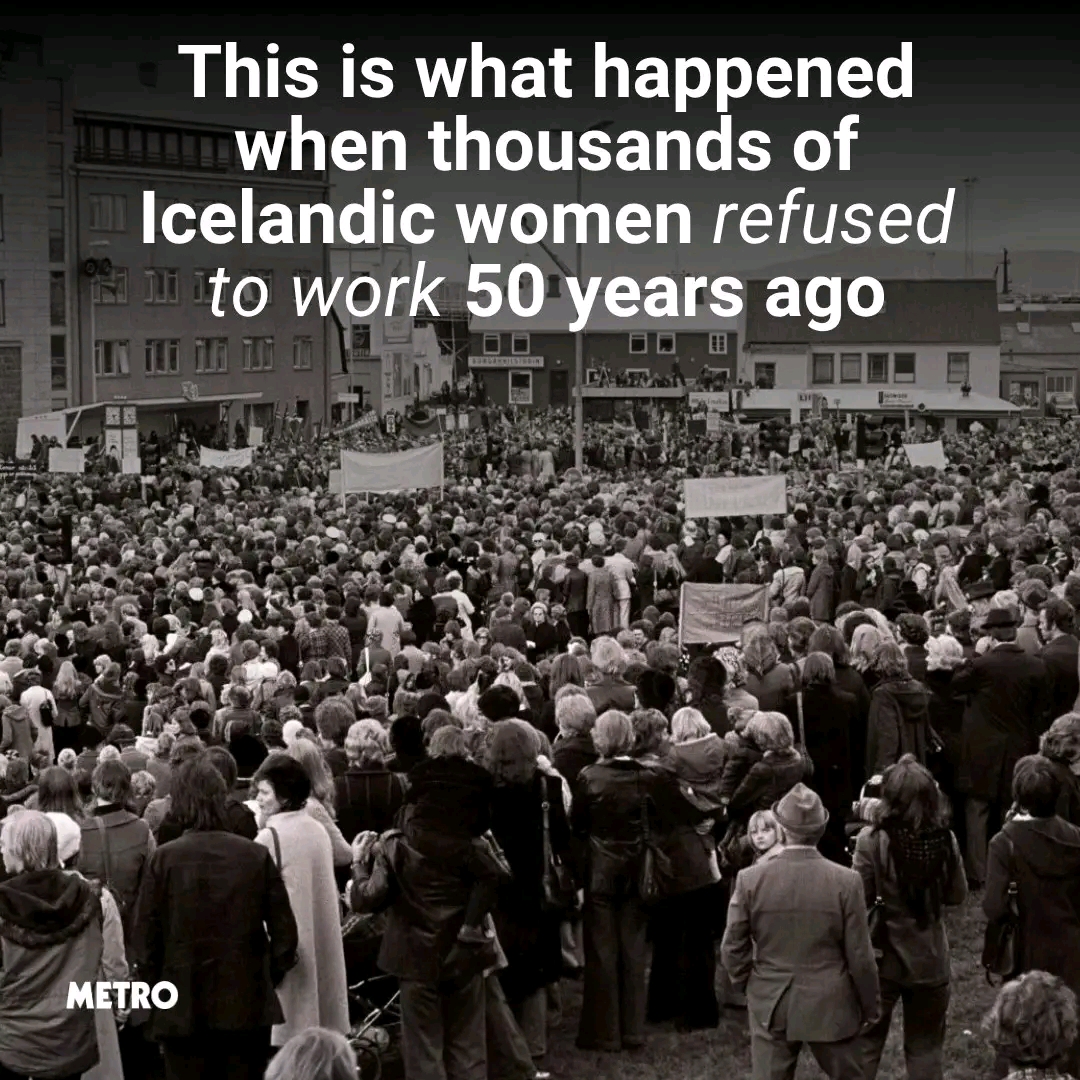CELEBRITY
This is what happened when thousands of women refused to work in Iceland 50 years ago

It was eerily quiet on the suburban streets of Iceland on October 24, 2023.
Schools weren’t open, swimming pools closed and several banks shut early. Meanwhile all-male news teams announced shutdowns across the country with buses delayed, hospitals understaffed and hotel rooms uncleaned.
That was because the majority of Iceland’s women were not at work or at home looking after children; instead they had gathered in downtown Reykjavík and other cities and towns across the country.
The 100,000-strong group, made up of women and non-binary people, were taking part in the yearly protest called kvennafrí [Women’s Day Off in English], which calls for an end to unequal pay and gender-based violence by refusing to work, cook and look after children for a day.
While different variations of ‘Women’s Day Off’ had been taking place on the same date every year since 1975, what made 2023 all the more poignant was the huge numbers of attendees – far bigger than ever before – and among the campaigners refusing to work were Prime Minister Katrín Jakobsdóttir and Iceland’s First Lady Eliza Reid.
Women in Iceland could vote, get an education and run for public office by the 1970s. But they were still hugely underrepresented in the Parliament, only making up 0-5% of politicians. As a result, a movement called the ‘Red Stockings’ entered society in 1970.
Along with similar groups, the Red Stockings decided to organise ‘something amazing’ for the United Nations ‘Women’s Year’ in 1975. Women would down tools and stop working in a bid to get men to listen to their concerns. They named the protest ‘Women’s Day Off’ instead of ‘Women’s Strike’ to not risk women being fired by employers. Stickers were printed and appeared on clothing, handbags, walls and windows, as thousands of women put Friday October 24, 1975 in their diary.
They included Kristín Ástgeirsdóttir, a 22-year-old history student at the University of Iceland. She’d been brought up in Vestmannaeyjar, a fishing community in Iceland, by her nurse mother and writer father.
‘It was like a wave,’ Kristín tells Metro. ‘Women would ask each other “are you going?” at work or on the street. The word spread. On the day, around 2pm, we started streaming down the streets to this meeting. To see all those women, to feel the energy, it was fantastic.’
Women gave speeches and sang songs as the day passed and, at one point, a brass band performed the theme tune to ‘Shoulder to Shoulder’, a BBC series about the Suffragette movement which had been popular in Iceland. It was estimated that 90% – 30,000 – of the nation’s women had taken part in the demonstration.
Meanwhile, men took children to work or remained home to care for them. According to local reports, foods like Bjúga – a smoked sausage which doesn’t require cooking – ran out in many supermarkets.
Radio presenters called households in rural towns and villages to ask if women were taking part in the protest and – for the most part – had the phone answered by men who confirmed this was the case. Fish factories were forced to close since so many of the workers were female and telephone switchboards were unmanned.
The Women’s Day Off was referred to as ‘long Friday’ by some fathers.
Did the protest change anything?
The 1975 march galvanised a generation of women in Iceland.
By 1983, they had gained 15% of parliamentary seats compared to just 5% a decade before. Vigdís Finnbogadóttir came to power in Iceland in 1980, becoming the world’s first democratically elected female president.
At the time, Kristin was a journalist at a radical left-wing newspaper. She recalls from this time: ‘Seeing and hearing the discussion around Finnbogadóttir – she was divorced, she had adopted a child, she had had cancer – made me so angry.
Some men thought it was impossible for a woman like that to be in power. But she did win and that was fantastic, it meant a lot for the next generation of women to see a woman in this top position.’
Finnbogadóttir was president until 1996 and further history was made in 2009 with the election of Jóhanna Sigurðardóttir as Prime Minister of Iceland – and the world’s first openly gay PM.
Meanwhile, Women’s Day Off protests continued, albeit on a smaller scale.
In 2010 for example, many women packed their bags and left work at 2:25pm to highlight the gender pay gap and how the time they essentially stopped getting paid compared with men’s earnings. Similarly, in 2016, Icelandic women left work at 2.38pm, while in 2018, they went home at 2.55pm.
Without today’s social media or rolling news, coverage of the 1975 march may have been confined to local newspapers. But due to one very fishy situation, that was not the case.
In 1975, Britain and Iceland were embroiled in the third ‘Cod War,’ a bitter feud over fishing rights. Journalists from Britain had been in Reykjavík for a crunch meeting on October 15 and several decided to stay on and cover the Women’s Day Off march.
‘Icemaidens give their men the freeze’ and ‘Chaos reigns as Iceland’s women go on strike’ were among the headlines in the British press. On October 24, 1975, the Coventry Evening Telegraph reported ‘men, who initially treated the strike as a joke, began to take the point.’
Fast forward nearly 50 years and the story of the 2023 mass walk-out was covered by news outlets across the world, from the Guardian to CNN. The event had marked the first full-day women’s strike in Iceland since 1975.
On the day of the protests in 2023, gender studies researcher Dr. Finnborg Salome Steinþórsdóttir stood nervously outside the University of Iceland. She had posted in Facebook groups and sent out emails about the event to her colleagues. Yet, the mum-of-one was paranoid no-one would heed her call.
Finnborg, 39, tells Metro: ‘I thought “this could be embarrassing, what if no-one turns up and I’m there alone?.” But then more and more people started to arrive. We had 1,000 people alone from the university in the end. I remember taking a photo as we walked towards downtown Reykjavík – we took up the entire street! There was a sense of solidarity in the air.’
The group wanted to take aim not only at VAWG and the gender pay gap, but also tackle the wider undervaluation of women’s jobs; such as the gender segregation between traditional ‘female’ jobs like care and education compare to ‘male’ jobs and expectations in finance and business.
As the protestors marched around Tjörnin lake and made the streets of Reykjavík their own; they walked in the footsteps of revolutionaries who took part in the first monumental Women’s Day Off in 1975.
While feminists in Iceland have vowed to keep fighting and the country has organised a series of discussions and events to mark 50 years since the start of Women’s Day Off, the reality of the situation is stark.
Rather than shrinking, the gender pay gap has widened, going from 8.6% in 2022 to 10.4% in 2024, while 4 in 10 Icelandic women have been sexually or physically assaulted.
Kristín has been a student, a journalist, a politician, an activist and an academic throughout her life. She is now 73 and part of the group which has been organising 2025’s year of action. What keeps her fighting? What stops her from giving up?
The activist pauses and takes a sip of tea out a Moomin mug [creator Tove Jansson is a feminist icon to many in Nordic nations] before answering.
‘I was brought up with the belief that our role in society is to make it better. It is important we stay awake. We see how easy it can be for men to take rights away; we have seen that in Afghanistan, in Russia,’ she says.
‘We can’t give up or forget the history of women and the history of feminism. If we learn from our history, we know what we are dealing with in our future.’












